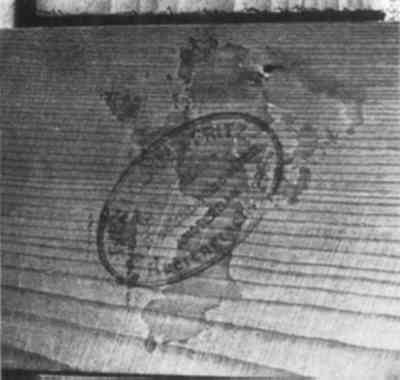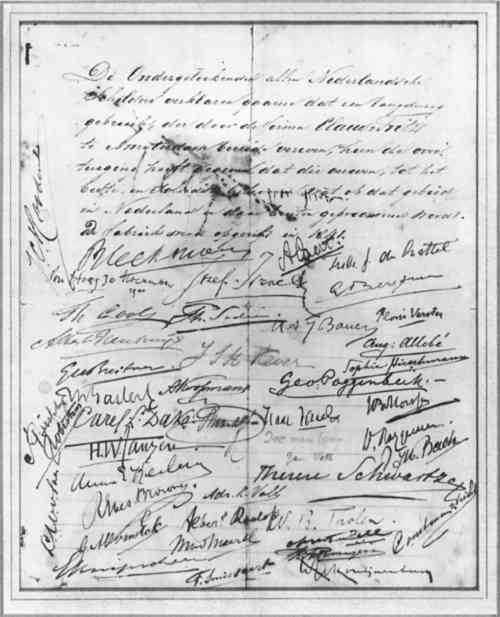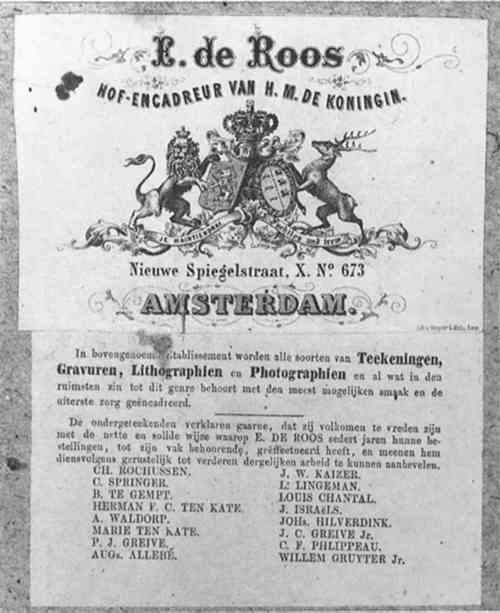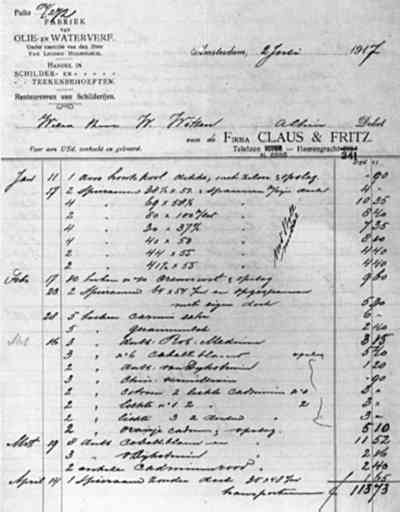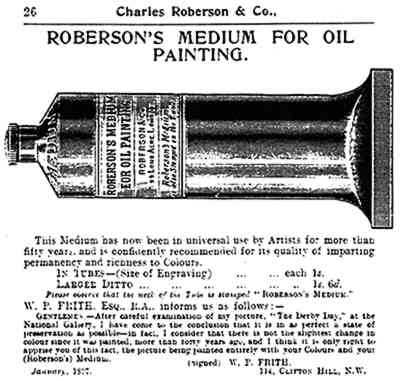WITH PAINT FROM CLAUS & FRITZ: A STUDY OF AN AMSTERDAM PAINTING MATERIALS FIRM (1841–1931)MICHEL LAAR, & AVIVA BURNSTOCK
ABSTRACT—Claus & Fritz was an Amsterdam-based firm that manufactured and supplied artists' drawing and painting materials from 1841 to 1931. Original sources have been used to document the founding of this company, its patronage by contemporaneous artists, the range of materials it supplied, and the quality controls it applied to its products. Claus & Fritz manufactured a range of its own oil-based paints, supplied in tin tubes. Analysis of the inorganic pigments and binding media of 41 different paints from its 1921 line was carried out in this study. The results of the analysis characterize the range of pigments and mixtures used, including extenders, and the use of additives such as beeswax and resin to the linseed oil binding media of the tube paints. TITRE—Une �tude de l'entreprise amsterdamoise “Claus & Fritz” de mat�riel de peinture (1841–1931). R�SUM�—De 1841 � 1931, l'entreprise amsterdamoise Claus & Fritz manufactura et fournit des mat�riaux pour la peinture et les arts graphiques. Des documents d'origine ont permis de retracer la fondation de la compagnie, sa client�le d'artistes � l'�poque, l'�ventail des mat�riaux fournis, et les contr�les de qualit� auxquels les produits �taient soumis. L'entreprise Claus & Fritz fabriquait une partie de ses propres peintures � l'huile, qui �taient vendues en tubes de fer. Cette �tude pr�sente l'analyse des pigments inorganiques et du liant de 41 diff�rentes peintures de leur ligne de production de 1921. Les r�sultats d�crivent la gamme des pigments et m�langes utilis�s dans les peintures en tube, ainsi que les mat�riaux de charge et les additifs, tels que la cire d'abeille et la r�sine, employ�s dans les peinture � l'huile de lin. TITULO—“Con pintura de Claus & Fritz”: Estudio de una firma productora de materiales de pintura en Amsterdam (1841–1931). RESUMEN—Claus & Fritz fue una firma de Amsterdam que produjo y fue el distribuidor de materiales para dibujo y pintura para artistas, desde 1841 hasta 1931. Se utiliz� documentaci�n original para investigar la fundaci�n de la compa�ia, los artistas contempor�neos que constituyeron la clientela, el rango de materiales que vend�a y los controles de calidad con los cuales fabricaba sus productos. Claus & Fritz produc�a una linea de pinturas al �leo que distribuia en tubos de esta�o. El trabajo que se presenta contiene los an�lisis de los pigmentos inorg�nicos, los aglutinantes de 41 pinturas diferentes de su linea del a�o 1921. Los resultados identifican el rango de pigmentos y mezclas, incluyendo materiales de carga, y el uso de aditivos tales como cera de abejas, resina y aceite de linaza utilizados como aglutinantes en los tubo de pintura. 1 INTRODUCTIONOn the backs of canvases and panels, as well as on frames and stretchers, helpful information can sometimes be found regarding the provenance, dating, and attribution of a painting. That valuable evidence such as labels, numbers, seals, and stamps should be preserved goes without saying. In 1993 two labels of the firm of Claus & Fritz, suppliers of artists' materials, were documented on the stretchers of two paintings by Gerrit Willem Dijsselhof (1866–1924) (fig. 1). Later that year, in the Van Beek artists' supplies shop on Stadhouderskade in Amsterdam, which is now nearly 100 years old, another piece of
The signatories were J. C. Roodenburg, A. Coert, W.C.C. Bleckmann, Jozef Israels, G. Bergsma, F. J. van Rossum du Chattel, T. Cool, P. Sad�e, M.A.J. Bauer, Floris Verster, Albert Neuhuijs, J.S.H. Kever, A. Alleb�, Sophie Hirschmann, G. H. Breitner, N. Bastert, A. Koopmans, G. Poggenbeek, S. Bisschop-Robertson, Carel L. Dake, P. N. van Agt, Isaac Israels, W. B. van Horssen, H. W. Jansen, J. van Looy, Jan Veth, D. Roggeveen, J. M. Bach, C. W. van Laer, Anna E. Kerling, Th�r�se Schwartze, R. Ives Browne, A. L. Valk, G. H. van Eck, Albert Roelofs, W. B. Tholen, M. van der Maarel, H. van der Poll, Constance van Tricht, E. Knipscheer, F. Smissaert, B. Bongers, and W. A. van Konijnenburg. Most of the signatories were members of Arti et Amicitiae, an artists' society in Amsterdam, or of Pulchri Studio, an artists' society in The Hague. Most were born in the 1850s. By far the oldest among them was Jozef Israels, who was probably the first to sign, since the date appears to be in the same hand as his signature. The other signatures were added at different times, and the artists need not be regarded as a single group at any one time or place. The initiative was obviously a commercial one on the firm's part, but the idea was not unique; witness the presence on a mounting board in an empty frame in the Rijksmuseum of a printed label of the frame maker E. de Roos of Amsterdam, which dates from before 1870 and is signed by 16 artists (fig. 3). Here the commercial intentions are again very clear. The idea of such a recommendation by artists may have come from England, where in 1869 a similar recommendation, in this instance for “Improved Studio Easels,” was printed in an advertisement for Winsor and Newton (Field 1869, 38–39)(fig. 4). It is not inconceivable that the signatories also gained some sort of financial advantage, a discount on future orders, for example.
Since the signatories of the Claus & Fritz testimonial must all have been among the firm's customers, we now know the names of 43 painters who certainly must have acquired their materials from the Amsterdam concern. The fact that a number of them lived in The Hague, and later became known as The Hague School of Painters, testifies to the firm's importance. Its reputation is also suggested by a letter of 1903 to the critic Albert Plasschaert from Willem Bastiaan Tholen (1860–1931), who, in response to a request for biographical details, summed up his life as follows: “Born in Amsterdam in 1860 and not dead yet, paints with paint from Claus & Fritz” (De Jong 1994, 159). 2 THE FIRM OF CLAUS & FRITZThe founder of the firm in 1841 was Pieter Claus Jr. (1778–1864), a painter of landscapes and townscapes. That same year it moved into the premises at 295 Herengracht, where it remained for more than 50 years (fig. 5). In 1853 Harmina Christina Louisa Claus (1834–99), (fig. 6), Pieter's daughter by his second wife, married the painter Johannes Fritz (1823–91) and from that year on the firm appeared as Claus & Fritz in the directory of the leading inhabitants of Amsterdam, although Claus also kept his own entry in the directory until his death. From 1856 on the entry read “Claus (P.) Art Dealers in Painting and Drawing Materials, Claus & Fritz, at the address given above.” The letter of recommendation indicates that the firm manufactured paints from 1841, but whether they and other artists' requisites were made at the same address as the shops unclear. The premises there were certainly none too large. That the firm also dealt in paintings is clear from these entries as well as from the account books of Cornelis Springer (1817–91), from whom it bought six pictures between 1842 and 1862 (Laanstra et al. 1984, cat. nos. 42–3, 52–2, 52–5, 54–4, 54–16, and 62–5).
After Claus's death the firm retained the name Claus & Fritz, as it did again after Fritz's death in 1891, when it was continued by the art dealer and painter from Gouda, Bartholmeus Johannes van Maare (1837–1913), who bought the Herengracht premises on Fritz's widow's death in 1899. In 1909 the descriptive “Art Dealers” was dropped from the firm's title, which now read “Makers of Oil and Water Colors in Tubes, Canvas, etc. Dealers in Painting and Drawing Materials” (fig. 7).
After Van Maare's death the firm was taken over by his sons Jacobus (b. 1866) and Dirk (b. 1868), who sold 295 Herengracht in 1913 and on January 1, 1914, turned the business into a limited company under the same name, although “Van Maare Brothers” was now added in brackets after the name Claus & Fritz in advertisements. The new premises were at 341 Herengracht (fig. 8). The Van Maare brothers made not only “Fine Oil and Water Colors in Tubes” but also paper, canvas, and panels for painters. An advertisement in the 1915 catalog of the Moderne Kunstkring in Amsterdam reveals that they also sold “study paint,” presumably a student grade paint of lower price. The firm finally went into liquidation in 1931, probably driven out of business by the competition not only from imported paints in the early 20th century but also from the firm of Talens, founded in 1899, which rapidly captured the lion's share of the Dutch market in the 1920s.
3 THE CUSTOMERSThe growing demand for ready-made artists' materials in the 19th century was partly due to the rise in the number of amateur painters, who found it difficult to make paints for themselves as professional artists had done in earlier centuries. At the same time many professional artists began to paint out of doors, often in locations far from home, so that there was a need for well-packaged materials ready for immediate use. New technology also made it possible for artists' materials to be made by machinery. The question of who met these needs in the Netherlands has scarcely been answered as yet (Pey 1987). By studying artists' bills, notes, and inventories, however, it is possible to gain an idea of what materials were used and how and who provided them. The notebooks of G. H. Breitner (1857–1923) (Rijksbureau voor Kunsthistorische Documentatie) show him buying paints from Claus & Fritz in 1900 and 1901, but more insight is provided by seven bills sent by the firm to Willem Witsen (1860–1923) between 1908 and 1920 (Stichting Willem Witsenhuis) (fig. 8). These bills list all manner of paints, watercolors, brushes, charcoal, chalk, paper, stretchers, panels, and “our own (red) canvases”—presumably a specialty of which little is known. It seems unlikely that canvases would have been prepared in the Herengracht premises, so the firm must have had another location for that. Witsen's purchases of varnish consisted of six bottles of painting varnish, three of retouching varnish, and three double ones of mastic varnish. He also Two interesting references in Witsen's bills are those of 1918 and 1920 to Roberson's Medium (fig. 9), a binding medium probably obtained by Claus & Fritz from the trade printers, bookbinders, and arts supply shop A. J. Nuss of Reguliersbreestraat in Amsterdam (established in 1861), which imported it directly from Roberson's in London between 1915 and 1922 (Roberson Archive;, Carlyle 1991). Witsen may have discovered this megilp when working in London from 1889 to 1891.
4 THE PAINTThe Van Beek firm still possesses a tube of sap green paint from Claus & Fritz (fig. 10), while in Dijsselhof's paint box at the Drents Museum at Assen, in addition to a few tubes of the manufacturers Oud Hollandse (Scheveningen), P. Briault (Paris), Dr. Fr. Schoenefeld (D�sseldorf), H. Schmincke & Co. (D�sseldorf), and Schouten en Voskuyl (Amsterdam), there are at least 62 Claus & Fritz tubes containing oil paint in 34 different colors. The tubes come in four different sizes, and one of them, emerald green, is labeled “Study Oil Paint.” Since the tubes have been little used, Dijsselhof probably bought them toward the end of his life. The Rijks-prentenkabinet in Amsterdam also has a box with many Claus & Fritz tubes, which came from the painter Hendrik van Borssum Buisman (1873–1951), who was also curator of the Teylers Museum at Haarlem.
A good idea of the range of colors sold by the firm is also given in a price list issued in January 1928 by the Amsterdam firm of A. J. van der Linde (fig. 11). The wide assortment listed under the name Claus & Fritz includes cadmium colors, modern pigments that only came into commercial production around 1910 (Gettens and Stout 1966, 149). They illustrate that Claus & Fritz offered modern pigments, while the firm's thoroughness is indicated by the presence of
5 CONTROLThe letterheads of all Claus & Fritz's bills to Willem Witsen (Stichting Willem Witsenhuis) also mention “Restoration of Paintings,” an aspect about which nothing more is known since there are no extant archives of the firm. From 1917 onward there also appears the line: “Manufacturers of Oil and Water Colors. Under the control of Mr. van Ledden Hulsebosch.” This is a reference to the Amsterdam criminologist and scientific adviser to the Criminal Investigation Department, C. J. van Ledden Hulsebosch (1877–1952) (fig. 12), a celebrity in his day whom the newspapers dubbed “the Sherlock Holmes of Amsterdam.” Claus & Fritz evidently considered the quality of their products important enough to warrant taking on an independent controller, who presumably would have conducted regular tests to ensure the fineness, authenticity, and quality of the pigments. Van Ledden Hulsebosch carried out similar product control on the flavorings of Maggi in Amsterdam and the tubular lights made by Philips of Eindhoven.
Van Ledden Hulsebosch was also interested in modern methods of examining works of art. In his popular Veertig Jaren Speurdswerk (Forty Years of Detective Work) (1945) he described how, after World War I, he brought the first ultraviolet lamp to the Netherlands. After a great deal of difficulty he became the first in the country to examine oil paintings by Old Masters by UV radiation in order to discover signatures that were completely invisible in ordinary light. The difficulty was particularly severe when the painter had signed his name in one of the very luminescent types of paint such as zinc white or other paints containing zinc or in a nonluminescent paint on a luminescent ground (Van Ledden Hulsebosch 1945, 166). In addition to acknowledging his services, Van Ledden Hulsebosch's name on the firm's letterhead also had a commercial intention much like the signed document of 1900. 6 RECENT ANALYSIS OF THE MEDIUMThe 20 Dijsselhof tubes and the sap green belonging to Van Beek were examined by J. J. Boon of the FOM Institute for Atomic and Molecular Physics in Amsterdam. They were analyzed with direct temperature-resolved mass-spectrometry with an JEOL SX-102A double-focusing mass-spectrometer (Boon 1992). With this method of analysis one obtains a picture of the oils, waxes, and resins in the paint in addition to information about polymer fractions such as the oil paint network polymer, proteins, polysaccharides, and metals like lead, cadmium, mercury, and iron (Boon et al 1995; Boon and Van Och 1996). The paint samples were dissolved and suspended in toluene:ethanol:ethyl acetate (40:5:5), whereupon a few micrograms of the paint suspension were placed on a platina/ rhodium filament probe and heated to a high temperature (800�C). The evaporation and pyrolysis products were analyzed using mass-spectrometry with low electron volt (eV) electron impact ionization (16 eV) at the mass range of 20–1000 atomic mass unit (M/Z). Drying oil appears to be the main component in the 21 samples studied, albeit its precise nature is not clear because classification is normally based on saturated fatty acids in hardened paint while the samples had to be taken from not yet hardened paint (Mills and White 1994). In some cases irregularities were found that would indicate unusual oil components. The possibility that these were oxidation products of triglycerides is being studied further by Boon. In one semihardened sample taken from the outside 7 TECHNICAL EXAMINATION OF THE PIGMENTSThe initials “W. D.,” in pencil, had been written on the labels of all the paint tubes in the paintbox of Gerrit Willem Dijsselhof. On one of the tubes of Terre de sienne was written “Mei 21” (May 21). Because the tubes were still full and in good condition, it seems likely that they were purchased by Dijsselhof toward the end of his life. It is tempting to attribute the tubes of Van Borssum Buisman to the same years due to the similarity of design and printing on the label. Samples of the paint were prepared for analysis of the inorganic pigments using light microscopy and energy dispersive x-ray spectroscopy (EDX). Samples were taken by Aviva Burnstock at the Courtauld Institute of Art in London in January 1996. Particle characterization of selected samples was carried out using secondary electron imaging with a scanning electron microscope (SEM). The results of the analysis are presented in table 1. The following discussion summarizes points of interest from the analyses of the paints. TABLE 1 RESULTS OF SEM-EDX RESEARCH ON CLAUS & FRITZ COLORS 7.1 ADDITIONS AND EXTENDERSCalcium carbonate (probably precipitated chalk) is the most extensively used addition to the tube paints in this series. It is added to the black pigments, all the paints based on iron oxide pigments and greens including terre vert, sap groen, cobalt groen (nos. 1 and 3), and ultramarin guimet (extra). The proportion of chalk added varies, for example, brun d'mars contains a relatively small amount of chalk, while oranje d'mars contains a relatively high proportion. In general, the lighter shades of earth colors contain proportionally more chalk than the darker colors. This finding may suggest that chalk functions not only as an extender but is added to lighten the color of the paint. Another possibility is that more chalk was added to the light colors because it would be less noticeable than if added to the dark colors. Barium sulphate, found in some of the oker colors (in addition to chalk) fulfills a similar role. Optically, particles are characterized by large, translucent glassy shards that have low birefringence in polarized light and an intermediate refractive index. On this basis they were identified as barite, the naturally occurring form of barium sulphate (Feller 1986). Paints that include barite without chalk are cobalt groen no. 3 and smaragd groen. Barite was used as an extender for paints from the last decade of the 18th century. Because it has low oil absorption, addition of barite to pigments that are highly oil absorbing may reduce the total oil content of the paint formulation. Drying of the paint is enhanced both by increasing the pigment volume concentration and by providing a relatively large particle surface area. More transparent colors contain neither chalk nor barite. These include the lake pigments carmin fix de garance and donkere gekristalliseerde kraplak and the more transparent earth colors violet d'mars and paarsche dodekop. Other paints without extenders are cobalt (blue), the three white pigments—zincwit (zinc oxide), loodwit (lead carbonate), and cremswit (a mixture of lead carbonate and zinc oxide), and the series of colors based on cadmium. Silica in the form of quartz has been added to half gebrande geel oker. Aluminum is added, probably in the form of aluminum hydroxide (Al(OH)3), to all pigments except the white pigments, cadmium rood, vert veronese, and cobalt groen no. 3. 7.2 PIGMENTS BASED ON IRON OXIDEThe range of oil colors offered by Claus & Fritz include paints made using a variety of grades of natural and artificial pigments based on oxides of iron. In general, the paints made using natural iron oxides (including the range of okers, siennes, and ombers, and paarsche dodekop) contain coarsely ground particles of variable size and shade, while the artificial iron oxide pigments used for the mars colors contain submicron-sized particles of a uniform color. Colors based on natural earth pigments can be grouped according to proportions of trace elements revealed in semiquantitative EDX analysis: Okers contain a relatively high proportion of silica, trace amounts of potassium, and occasionally titanium, and terre de siennes contain similarly small proportions of potassium and silicon. Ombers are distinguished by the presence of manganese, and most of the mars colors contain trace amounts of silica without potassium. Terre vert was also identified as containing the characteristic silicates of aluminum, magnesium, potassium, and calcium, used together with other pigments to make a range of green colors (discussed in more detail below). The range of shades was achieved in some cases by mixing two grades of earth color. For example, the medium brown shade of bruin oker contains a mixture of brown and yellow particles, and roode oker is made with a proportion of finely ground red (similar to the mars pigments) with coarser brown earth pigment. A variety of shades of the same combination of pigments has been achieved by adding different proportions of the various extenders. For example, geel oker, the palest shade of iron oxide yellow, contains additions of both chalk and barite, the darker shade gebrande geel oker contains chalk, with only traces of barium and sulphur, while the middle color (half gebrande geel oker) contains chalk and silica. Similarly, omber contains chalk and barite, while the darker gebrande omber is extended with a little chalk only. Zinc white has been added to two of the iron oxide colors, omber and paarsche dodekop, presumably to modify the shade. While omber contains both extenders as well as a significant amount of zinc white, the more transparent paarsche dodekop is made from an iron oxide pigment similar in color to that found in violet d'mars, with little zinc white and no other extenders. 7.3 PIGMENT MIXTURESA few paints were made using combinations of pigments with different qualities in order to extend the range. Engelsch rood contains a combination of an artificial red iron oxide with a red lake pigment to give a red paint with transparency between a pure lake and the relatively opaque red earth colors. Chineesche vermillioen contains a proportion of cadmium red in addition to red mercuric sulphide, perhaps designed by the manufacturer to create an attractive darker shade of vermilion that could be marketed in addition to a more orange shade of pure artificial red mercuric sulphide. All the green paints contain mixtures of pigments. Terre vert contains a small proportion of viridian, and the darker shade, gebrande terre vert, contains umber. Sap groen contains a mixture of terre vert (green earth), bone black, and yellow ochre. Smaragd groen contains viridian modified with some red earth pigment, while cobalt groen no. 3 is differentiated from cobalt groen no. 1 by the addition of viridian to the main component, cobalt green, a combination of cobalt and zinc oxides (CoO.ZnO). The blue paint, ultramarin guimet (extra) contains not only French ultramarine but additions of cobalt blue and red iron oxide. 7.4 PIGMENTS BASED ON CADMIUM, CHROMIUM, COPPER, COBALT, AND ANTIMONYIn addition to the iron-containing yellow pigments described above, the Claus & Fritz range included six pigments based on cadmium ranging from pale yellow (citroen cadmium) to red Pigments based on chromium include smaragd groen (chromium oxide viridian, discussed above) and a barium chromate yellow, paryt geel. Vert Veronese was found to consist of emerald green (copper aceto-arsenite) without added aluminum or extenders. Donker Napels geel contains lead and antimony, identified as Naples yellow and lead antimonate. The blue paint cobalt was found to be cobalt aluminate, and cobalt groen (nos. 1 and 3) consists of cobalt green, made by calcination of a cobalt salt with zinc oxide (McCrone et al. 1979, entry 935). 7.5 LAKE PIGMENTSCarmin fix de garance was identified as carmine lake. Based on the identification of the combination of elements calcium, aluminum, and sulfur, the lake base was deduced to be aluminum and calcium hydrous oxide (Ca.Al2O3. H2O.CaSO4) as described by McCrone et al. (1979, entry 931). Donkere gekristalliseerde kraplak contains a pink lake pigment that produced very low counts in elemental analysis. The proportions of the peaks suggest that the lake base is similar to that used for carmin fix de garance. This pigment was mixed with a small proportion of a red iron oxide pigment. Engelsch rood (discussed previously) is a mixture of a red lake with red iron oxide. 7.6 BLACK PIGMENTSTwo black pigments were included in the Claus & Fritz range. One was a carbon black, wijngaard zwart, which contain finely ground aggregates of carbon with a proportion of a black earth pigment. Ivoor zwart is brownish and contains calcium phosphate, bone black. 7.7 ANOMALOUS TRACE ELEMENTS: GERMANIUM, TIN, AND COPPERVleesch oker, paarsche dodekop, cadmium, lichte cadmium no. 1, and cobalt contain traces of the element germanium. Gebrande omber, oranje d'mars, jaune d'mars, paarsche dodekop, donkere gekristalliseerde kraplak, and ivoor zwart contain traces of copper, and several other colors contained traces of tin. Analysis of the metal tubes suggest that they are predominantly tin or (larger tubes) tin with lead. It is possible that traces of copper and possibly germanium may be associated with the metal tubes, although there may be a relationship between trace elements and the pigments or the process of manufacture of certain paints, which was not examined in detail. 8 CONCLUSIONSIt is hoped that this study will not only contribute to all aspects of 19th-century Dutch painting studies, thus materially assisting future restoration work, but also stimulate the examination of other paints used in the Netherlands and elsewhere in the 19th and 20th centuries. ACKNOWLEDGEMENTSSpecial thanks to Patricia Wardle, Monique Berends-Albert, and Elisabeth West FitzHugh. With thanks also to Hero Boothroyd Brooks London (for fig. 4); the Stichting Willem Witsenthuis, Amsterdam (for fig. 8); and Sally Woodcock, Roberson Archive, Hamilton Kerr Institute, Cambridge (for fig. 9). The ownership copyright of material in this archive is held by the Fitzwilliam Museum; it is published and quoted herein by permission of the Syndics of the Fitzwilliam Museum. Some of this material was first published in Dutch (van de Laar 1995). REFERENCESBoon, J. J.1992. Analytical pyrolysis mass spectrometry: New vistas opened by temperature resolved in source.. PYMS, International Journal of Mass Spectrometry and Ion Processes118/119: 755–87. Boon, J. J., J.Pureveen, D.Rainford, and J. H.Townsend.1995. The opening of the Wallhala, 1842: Studies on the molecular signature of Turner's paint by direct temperature-resolved mass spectrometry (DTMS). In Turner's painting technique in context, ed.J. H.Townsend.London: United Kingdom Institute for Conservation. 35–45. Boon, J. J., and J.VanOch. 1996. A mass spectrometric study of the effect of varnish removal from a 19th-century solvent-sensitive wax-oil painting. ICOM Committee for Conservation preprints, 11th Triennial Meeting, Edinburgh. London: James and James Science Publishers. 197–206. Carlyle, L. A.1991. A critical analysis of artist's handbooks, manuals, and treatises on oil painting published in Britain between 1800–1900: With reference to selected eighteenth century sources. Thesis, Cambridge University. deJong, A.1994. Willem Bastiaan Tholen (1860–1931). Assen: Drents Museum. Drents Museum, Assen, The Netherlands. \Feller, R. L.1986. Artist's pigments: A handbook of their history and characteristics, vol. 1. Cambridge: Cambridge University Press. Field, G.1869. Satter's edition of Field's chromatography. London: Winsor & Newton. 38–39. Gettens, R. J., and G. L.Stout. 1966. Painting materials: A short encyclopedia. New York: Dover Publications. Laanstra, W., H. C.De Bruyn, and J. H. A.Ringeling. 1984. Cornelis Springer (1817–91). Utrecht: Tableaux. Mayer, R.1991. The artist's handbook of materials and techniques. Boston: Faber and Faber. McCrone, W., J. G.Delly, and S. J.Palenik. 1979. The particle atlas. 2d ed. Vol. 5, Lig microscopy atlas and techniques. Ann Arbor: Ann Arbor Science Publishers. Mills, J. S., and R.White. 1994. Organic chemistry of museum objectsLondon: Butterworths. Pey, E.B.F.1987. De firma Michiel Hafkenschied & zoon. Een negentiende-eeuwsehandel in schildermaterialen te Amsterdam. Bulletin Koninklijke Nederlandse Oudheidkundige Bond (Amsterdam)86(2): 49–70. Rijksbureau voor Kunsthistorische Documentatie, The Hague. Rijksmuseum, Amsterdam. Rijksprentenkabinet, Amsterdam. Roberson Archive, Hamilton Kerr Institute, Cambridge University, England, HKI MS 387–1993, 175, 277. Stichting Willem Witsenhuis, Amsterdam. van deLaar, M.A.A.M.1995. “… met verf van Claus & Fritz: Onderzoek naar een Amsterdamse firma in schilderen tekenbehoeften (1841–1931). Bulletin van het Rijksmuseum43(3): 195–208.
vanLedden Hulsebosch, C. J.1945. Veertig Jaren Speurderswerk. 2d ed.. Utrecht: Kemink and Zoon N.V.157–67. AUTHOR INFORMATIONMICHEL VAN DE LAAR has been paintings conservator at the Rijksmuseum in Amsterdam since 1989. He trained in Brussels, Louvain-la-Neuve, and the Rijksmuseum. Later he was an intern for shorter periods in the Statens Museum for Kunst in Copenhagen (1991), the J. Paul Getty Museum in Malibu (1992), and the Courtauld Institute of Art in London (1995). Address: Rijksmuseum, Postbus 74888, 1070 DN Amsterdam, The Netherlands. AVIVA BURNSTOCK is a lecturer in the Department of Conservation and Technology at the Courtauld Institute of Art, London, where she completed a Ph.D and a diploma in the conservation of easel paintings. From 1986 to 1992 she worked in the Scientific Department of the National Gallery, London, after a year as a practicing conservator in Australia with the Regional Galleries Association of New South Wales. She has a B. Sc. in neurobiology from the University of Sussex, England. Address: Courtauld Institute of Art, Department of Conservation and Technology. Somerset House, Strand, London WC2R 0RN, England.
 Section Index Section Index |
